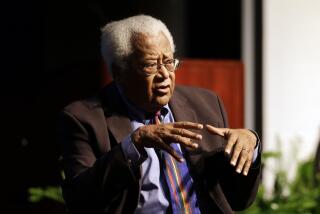‘Going Clear’ takes on Scientology’s celebrity fixation

- Share via
Who’d have thought a history of a religion would offer so many guilty pleasures? Lawrence Wright’s enthralling account of Scientology’s rise, “Going Clear: Scientology, Hollywood, and the Prison of Belief,” brims with celebrity scandal. To anyone who gets a sugar rush from Hollywood gossip, the chapters on Tom Cruise and John Travolta will feel like eating a case of Ding Dongs.
But celebrities are serious business in Scientology. L. Ron Hubbard, who founded his church in Los Angeles in 1954, recognized their value in attracting followers. Through a church publication, he urged adherents to recruit Marlene Dietrich, Bob Hope and Walt Disney, advising them, “If you want one of these celebrities as your game, write us at once so the notable will be yours to hunt without interference.”
Hubbard’s scheme to bag the famous yielded uneven results, but starting in the 1970s a wave of ambitious young unknowns entered his church. Lured by the promise of its newly opened Celebrity Centre, they sought fame (and enlightenment). Among them were Travolta and Cruise. Another was writer-director Paul Haggis. Despite the acclaim garnered by his Oscar-winning films, Haggis lived in comparative obscurity as a Hollywood Scientologist. That changed in 2009 when Haggis resigned from the church and became its best-known apostate.
Wright first wrote about Haggis’ break with Scientology in a 2011 New Yorker profile. He’d previously received a Pulitzer Prize for his reporting on Al Qaeda in “The Looming Tower”; taking on Scientology was arguably riskier. (In fact, the book’s British publisher, Transworld, announced that it was canceling publication.) But in Haggis he had a unique source. The success in Hollywood that had made Haggis so desirable to the church also made him a potent critic. Haggis quit the church over its failure to support gay rights, but in Wright’s original New Yorker piece, Haggis attacked the core of the church, calling its most sacred doctrines “madness.”
In “Going Clear,” Haggis’ story serves as a jumping-off point into the improbable life of L. (for “Lafayette”) Ron Hubbard. Possessed with colossal ambition from a young age, Hubbard told his first wife, “I have high hopes of smashing my name into history so violently that it will take a legendary form,” according to Wright.
Self-confidence is an esteemed American trait. Hubbard’s was coupled with a thirst for adventure and an imagination so vivid he lived his life as if it were a work of fiction. This is another way of saying he may have been a pathological liar, as he appears in Wright’s rendering. Born in 1911, Hubbard grew up in Montana yet had an odd seafaring life. His father was in the Navy, posted in Asia, and periodically Hubbard shipped out to visit him. In journals Hubbard mythologized his trips into grand adventures. He had nerve enough for real danger too. Dropping out of college, he became a stunt pilot. Then, he chartered a schooner, advertised himself as an experienced sea captain and led more than 50 paying customers on a “buccaneers” adventure to the Caribbean to explore pirate haunts. After a series of calamities, Hubbard jumped ship in Puerto Rico.
He discovered a form of adventure for which he was ideally suited: writing for pulp magazines. Words flowed so quickly, Hubbard typed onto a roll of butcher paper. He told editors that his stories about cowboys and explorers were autobiographical. He also claimed to be a nuclear physicist, but his inability, or unwillingness, to distinguish fact from fantasy was no problem then. Entering the Navy in World War II, it was. He talked his way into command of a warship, then during training, led his crew on an epic mission against Japanese subs that an inquest later determined had never existed. He was relieved of his command after another incident in which he ordered his men to bombard Mexico.
After the war, Hubbard drifted to California. Wright says that he told people he’d been grievously wounded. He couldn’t work and suffered from nightmares. Although his only combat had involved imaginary submarines, he displayed classic symptoms of what would now be called PTSD. He set about healing himself. Hubbard claimed his method was scientific yet came from revelations. He told friends that while undergoing oral surgery at the dentist’s office, he’d died, traveled to an alternate dimension, unlocked the secrets of the universe and returned in order to reveal them.
He called his method “Dianetics.” It was a blend of psychoanalysis, Eastern spiritualism and claims that those who achieved enlightenment — called becoming “Clear” — could boost their IQs and heal cancer. His book “Dianetics” became a bestseller in 1950 and touched off a movement. Over the next four years Hubbard organized it into a religion. Scientology, as he rebranded it, offered a lively creation myth centering on alien invasions and ancient atomic wars.
His gospel appears no more or less absurd than those on which other religions are based. In his, immortal beings fly around in space ships. In others, they walk on water. Is there really a difference? Many people found that the mental exercises and talk therapy sold by Scientology improved their sense of well-being. Those who attained enlightenment often believed they acquired the god-like powers that the church had promised them. When he was starting out, filmmaker Haggis had a close friend who marveled at what he believed was his new power to change traffic lights using his mind.
Hubbard’s real innovation was figuring out how to sell enlightenment more effectively than his competitors. Traditional churches offered it for free, then hoped for donations. In Scientology, novices were required to pay from the beginning.
A Scientology “church” was basically a place where books, tapes, classes and therapy sessions were sold. Enlightenment was sold in graduated steps. Those who got it could in turn open their own “missions” and run them like McDonald’s franchises, taking a share of the profits. The church became a cash machine, generating an estimated billion dollars in liquid holdings, in addition to a vast real estate empire. Those entering today can expect to pay as much as $300,000 to attain enlightenment, according to Wright.
“Going Clear” catalogs many abuses, from the covert effort to infiltrate the IRS to the church’s employment of ex-CIA officers to spy on its own members, as alleged by Wright. For many years, Hubbard led his church from a converted freighter with hundreds of followers aboard on whom he practiced all manner of strange punishments. Some were locked in hot boxes, fed gruel, dressed in rags. Others were “overboarded” — tied up and tossed in the sea (then fished out before drowning). Wright describes one instance in which Hubbard ordered followers “to race each other around the rough, splintery decks while pushing peanuts with their noses.”
Still, there was fun: Hubbard kept his followers active on the Italian coast hunting treasure that he said he’d buried in a past life.
There’s no shortage of insane anecdotes in “Going Clear.” Many involve Tom Cruise. Since Hubbard’s death in 1986, Cruise has become Scientology’s leading pitchman. Wright portrays him as being in the thrall of David Miscavige, the Rasputin-like figure who now runs the church. The most revealing story in the book concerns Miscavige’s alleged masterminding of a scheme to headhunt a young church member for Cruise to marry. According to Wright, after Cruise dumped her (to marry Katie Holmes), the church ordered her to scrub toilets with a toothbrush because she confided in a friend about her experience with Cruise and couldn’t stop crying.
One suspects Cruise was ignorant of her fate. That’s the main point in “Going Clear”: Enlightenment in Hubbard’s church may cause blindness.
Wright’s book comes at a time of heightened focus on Scientology. As he acknowledges, Janet Reitman’s book “Inside Scientology,” published in 2011, helped lay the groundwork for his expose. Yet for all the critical attention, Hubbard earns grudging respect. His religion, combining money, celebrity and enlightenment as it does, is unmistakably a product of Southern California. It may be the truest religion of the land.
Wright (no relation to Lawrence) is the author of “Generation Kill” and, most recently, the author of “How to Get Away with Murder in America,” published by Byliner.
More to Read
Sign up for our Book Club newsletter
Get the latest news, events and more from the Los Angeles Times Book Club, and help us get L.A. reading and talking.
You may occasionally receive promotional content from the Los Angeles Times.







